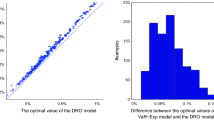Abstract
Searching for optimal solutions in terms of expected utility theory is reduced to minimizing a risk measure. The technique of polyhedral coherent risk measures is used to reduce the search for optimal portfolio solutions in the obtained problems to the appropriate linear programming problems.
Similar content being viewed by others
References
V. S. Kirilyuk, “Polyhedral coherent risk measures and optimal portfolios on the reward–risk ratio,” Cybern. Syst. Analysis, 50, No. 5, 724–740 (2014).
H. M. Markowitz, “Portfolio selection,” J. Finance, 7(1), 77–91 (1952).
H. M. Markowitz, Portfolio Selection: Efficient Diversification of Investments, Wiley, New York (1959).
D. Bernoulli, “Specimen teoriae novae de mensura sortis,” Comment Acad. Sci. Imp. Petropolitanae, V, 175–192 (1738).
J. Von Neumann and O. Morgenstern, Theory of Games and Economic Behavior, Princeton University Press, Princeton (1944).
L. J. Savage, The Foundation of Statistics, Wiley, New York (1954).
M. Allais, “Le comportement de l’homme rationnel devant le risque: critique des postulats et axiomes de l’ecole americaine,” Econometrica, 21, 503–546 (1953).
D. Ellsberg, “Risk, ambiguity, and the Savage axioms,” Quart. J. Econ., 75, 643–669 (1961).
D. Schmeidler, “Subjective probability and expected utility without additivity,” Econometrica, 57, 571–587 (1989).
I. Gilboa and D. Schmeidler, “Maxmin expected utility with non-unique prior,” J. Math. Economics, 18, 141–153 (1989).
V. I. Ivanenko and V. A. Labkovskii, The Uncertainty Problem in Decision Making [in Russian], Naukova Dumka, Kyiv (1990).
J. Quiggin, Generalized Expected Utility Theory: The Rank-Dependent Expected Utility Model, Kluwer Acad., Boston (1993).
M. E. Yaari, “The dual theory of choice under risk,” Econometrica, 55, 95–115 (1987).
G. Choquet, “Theory of capacities,” Annales de l’Institut Fourier Grenoble, 5, 131–295 (1955).
H. P. Wächter and T. Mazzoni, “Consistent modeling of risk averse behavior with spectral risk measures,” Europ. J. Operational Research, 229(2), 487–495 (2013).
C. Acerbi, “Spectral measures of risk: A coherent representation of subjective risk aversion,” J. Banking & Finance, 26(7), 1505–1518 (2002).
M. Rothschild and J. Stiglitz, “Increasing risk I: A definition,” J. Econ. Theory, 2, 225–243 (1970).
E. N. Sereda, E. M. Bronshtein, S. T. Rachev, F. J. Fabozzi, W. Sun, and S. V. Stoyanov, “Distortion risk measures in portfolio optimization,” in: J. B. Guerard (ed.), Handbook of Portfolio Construction. Contemporary Applications of Markowitz Techniques, Springer, New York (2010), 649–673.
S. S. Wang, V. R. Young, and H. H. Panjer, “Axiomatic characterization of insurance prices,” Insurance: Math. and Econ., 21(2), 173–183 (1997).
S. S. Wang, “A class of distortion operators for pricing financial and insurance risks,” J. Risk and Insurance, 67(1), 15–36 (2000).
A. Tsanakas and E. Desli, “Risk measures and theories of choice,” British Actuarial J., 9, 959–991 (2003).
Yu. M. Ermoliev and P. S. Knopov, “Method of empirical means in stochastic programming problems,” Cybern. Syst. Analysis, 42, No. 6, 773–785 (2006).
V. S. Kirilyuk, “Coherent risk measures and portfolio optimization problems,” Teoriya Optym. Rishen’, V. M. Glushkov Inst. of Cybernetics, NANU, Issue 2, 111–119 (2003).
P. Artzner, F. Delbaen, J. M. Eber, and D. Heath, “Coherent measures of risk,” Math. Finance, 9, 203–228 (1999).
R. T. Rockafellar and S. Uryasev, “Optimization of conditional value-at-risk,” J. Risk, 2, 21–41 (2000).
V. S. Kirilyuk and A. S. Babanin, “Polyhedral risk measures and robust solutions,” Teoriya Optym. Rishen’, V. M. Glushkov Inst. of Cybernetics, NASU, Issue 7, 66–72 (2008).
V. S. Kirilyuk, “Polyhedral coherent risk measures and investment portfolio optimization,” Cybern. Syst. Analysis, 44, No. 2, 250–260 (2008).
Author information
Authors and Affiliations
Corresponding author
Additional information
The study was partially supported by the International project within the frameworks of the cooperation with the International Institute of Applied Systems Analysis (IIASA), order of the Presidium of the NAS of Ukraine No. 212 of 2/28/2012.
Translated from Kibernetika i Sistemnyi Analiz, No. 6, November–December, 2014, pp. 63–72.
Rights and permissions
About this article
Cite this article
Kirilyuk, V.S. Expected Utility Theory, Optimal Portfolios, and Polyhedral Coherent Risk Measures* . Cybern Syst Anal 50, 874–883 (2014). https://doi.org/10.1007/s10559-014-9678-5
Received:
Published:
Issue Date:
DOI: https://doi.org/10.1007/s10559-014-9678-5



